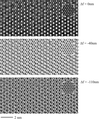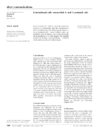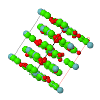issue contents
April 2003 issue

Cover illustration: Orange polytypically disordered crystals of HgI2 are built from layers of corner-linked Hg4I10 supertetrahedra. The stacking disorder has been quantitatively analyzed with a Markov chain model. Two probabilities describing next-nearest-layer interactions were adjusted to observed diffuse intensity profiles extracted from image-plate detector data. Results show nearly equal volumes of the two maximum degree of order structures, with an average domain thickness of about 5 layers or 30 Å [Hostettler, Birkedal & Schwarzenbach (2002), Acta Cryst. B58, 903-913].
research papers
Space group symmetry and the atomic structure of a nano-sized ordered phase in maraging steel 12Cr–9Ni–4Mo–2Cu have been determined using transmission electron microscopy.
A new model for the HA–OCP interface is presented and discussed. High-resolution transmission electron microscopy (HRTEM) image simulations are shown.
Download citation


Download citation


Multiple-twinned Sr (Ru
(Ru ,Pt
,Pt )CuO
)CuO has been studied by single-crystal X-ray diffraction and transmission electron microscopy.
has been studied by single-crystal X-ray diffraction and transmission electron microscopy.
The quantum chemical quantity exhibiting the same behaviour as the bond valence has been examined by molecular orbital methods related to Lewis-electron pair theory.
Download citation


Download citation


The incommensurately modulated, orthorhombic structure of the fresnoite framework-structure type compound Ba2TiGe2O8 has been solved based on neutron powder-diffraction data using a (3 + 1)-dimensional superspace approach.
An alternative superspace description of the trigonal compounds 

 O
O as a single modulated structure with discontinuous atomic domains is proposed. This approach highlights the layered character of the structures and can be applied with predictive power to other compound series, such as the orthorhombic compounds
as a single modulated structure with discontinuous atomic domains is proposed. This approach highlights the layered character of the structures and can be applied with predictive power to other compound series, such as the orthorhombic compounds 

 O
O .
.
Download citation


Download citation


An accurate experimental charge density study at 100 K of Mn2(CO)10 has been undertaken. The nature of the metal–metal and metal–ligand interactions has been studied by topological analysis and the results compared with DFT calculations at the 6-311+G* B3LYP level.
Download citation


Download citation


In salts formed by phosphonopropionic acid with organic diamines, the hydrogen-bonded substructures formed by the anions can be zero-, one- or two-dimensional, while the overall hydrogen-bonded supramolecular structures are three-dimensional.
Download citation


Download citation


Polarized molecular-electronic structures in N4-substituted 2,4-diamino-6-benzyloxy-5-nitrosopyrimidines lead to extensive charge-assisted hydrogen bonding, and supramolecular structures determined by five different types of hydrogen bond.
Download citation


Download citation


The crystallization of various mixtures of triphenylsilanol and 4,4′-bipyridyl has given a 1:1 adduct, Ph3SiOH·C10H8N2, and three polymorphic 4:1 adducts, (Ph3SiOH)4·C10H8N2, but no 2:1 adduct has been identified.
Download citation


Download citation


The end-functional groups impose similar packing on the title complexes, but the flexibility of one of the guest molecules results in a space group and cell dimensions that are observed for the first time in dimeric β-cyclodextrin complexes. However, this new lattice can be transformed into a lattice isostructural to that of the other inclusion complex.
short communications
In the selection of a centered cell in the monoclinic system, it is recommended that an I-centered cell be picked when it is the conventional cell. The common practice of using a skewed non-conventional C-centered cell should be discontinued.
This unusual crystal structure is placed in a more general context.


 journal menu
journal menu






























